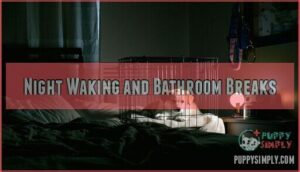This site is supported by our readers. We may earn a commission, at no cost to you, if you purchase through links.

This keeps them safe and helps establish good sleeping habits.
Think of it as creating a cozy den where your pup feels secure.
Most puppies need 2-3 months of consistent crate locking before they’re ready for freedom.
The key is making the crate comfortable with soft bedding and familiar scents.
Place it near your bedroom so you can hear if they need bathroom breaks.
Remember, young puppies can’t hold it all night.
Start with shorter periods and gradually increase as they grow.
Getting the timing and setup right makes all the difference for success.
Table Of Contents
- Key Takeaways
- When to Lock Puppy Crate at Night
- Benefits of Crate Training
- Introducing The Crate to Your Puppy
- Establishing a Bedtime Routine
- Night Waking and Bathroom Breaks
- Common Challenges and Solutions
- Long-term Use of The Crate
- Recommended Products for Crate Training
- Frequently Asked Questions (FAQs)
- Is it okay to lock a puppy in a crate at night?
- Should I leave my puppy crate door open at night?
- At what age can puppies go through the night without peeing?
- Should you ignore a puppy crying in a crate at night?
- How can I help my puppy adjust to being in the crate at night?
- What should I do if my puppy cries in the crate?
- What is the right size crate for my puppy?
- How long can I leave my puppy in the crate during the day?
- What should I do if my puppy has accidents in the crate?
- How often should I clean the crate?
- Conclusion
Key Takeaways
- You should lock your puppy’s crate at night during the training phase to keep them safe and establish good sleeping habits – most pups need 2-3 months of consistent crate locking before they’re ready for freedom.
- You’ll need to provide bathroom breaks based on your puppy’s age using the golden rule: one hour per month of age, meaning an 8-week-old needs breaks every 2 hours while a 4-month-old can wait about 4 hours.
- You can make crate training easier by creating a calming bedtime routine that includes tiring your puppy out with exercise, taking them for a final bathroom break, and using soothing sounds or dim lighting to signal sleep time.
- You shouldn’t ignore crying completely but should wait about 5 minutes before checking if they need a potty break – most puppies are ready to sleep with an open crate door between 4-6 months when they’ve mastered bladder control.
When to Lock Puppy Crate at Night
Locking your puppy’s crate at night isn’t about being mean—it’s about setting them up for success. Most experts recommend keeping that crate door secured until your pup reaches 4-6 months old or masters house training, whichever comes first.
Here’s the thing: nighttime safety becomes your top priority when you’ve got a curious puppy who might wander into trouble. Age considerations matter too—younger pups need more structure while they’re still learning bladder control.
Think of the locked crate as training wheels for good behavior. This routine establishment helps with anxiety management by creating predictable boundaries. Your puppy sleep crate becomes their safe haven, not a prison.
When you’re consistent with locking the crate at night, you’re teaching them that nighttime means rest time. To facilitate a smooth shift, consider if your puppy meets the readiness checklist criteria. Most dogs actually crave this structure once they adjust to their puppy crate training schedule.
Benefits of Crate Training
Think of crate training as giving your puppy their own bedroom.
The safety benefits are immediate – you’ll prevent midnight mishaps and protect your furniture from teething episodes.
Potty training accelerates because puppies naturally avoid soiling their sleeping space.
Your nighttime crate becomes a safe space where anxiety reduction happens naturally.
Routine establishment flows smoothly when your puppy sleep crate signals bedtime consistently.
These puppy crate training benefits create structure that helps both you and your pup sleep soundly.
It’s like having a security blanket with four walls, providing a sense of comfort and reassurance, which is a key aspect of successful crate training and can be considered a bedroom.
Introducing The Crate to Your Puppy
Think of introducing your puppy to their crate like showing a friend around your home – you want them to feel welcome and comfortable right from the start.
Making your puppy’s crate feel like home starts with patience, treats, and lots of positive energy.
The key is making this new space feel like a cozy retreat rather than a scary box, so your puppy will actually want to spend time there, which is crucial for creating a positive association with the crate and making the training process smoother, by emphasizing the crate as a welcome space.
Crate Size is Important
Getting crate dimensions right makes all the difference for your puppy’s comfort and safety concerns during nighttime crate training.
Your pup needs enough space to stand, turn around, and lie down without feeling cramped or overwhelmed.
Here’s what proper crate size looks like:
- Standing room: Your puppy can stand upright without their head touching the ceiling
- Turning space: They can spin around completely without bumping the walls
- Sleeping area: Enough room to stretch out comfortably on their side
Consider breed size and growth considerations when selecting your crate for the perfect comfortable fit.
Remember to keep in mind adult size requirements when choosing a crate.
Introduce The Crate During The Day
Start your daytime crate introduction by placing treats and toys inside while keeping the door open.
Let your puppy explore freely during supervised crate naps and crate playtime activities. This gradual crate acclimation builds positive crate associations before nighttime.
Feed meals inside to reinforce puppy comfort. These crate training tips guarantee your puppy bedtime routine flows smoothly with complete concepts of crate training in mind.
Establishing a Bedtime Routine
Creating a consistent bedtime routine makes crate training easier and helps your puppy settle down for the night.
You’ll want to tire them out with play, take them for a final bathroom break, and then use calming activities to signal it’s sleep time.
This process involves using these steps to make your puppy understand that it’s sleep time.
Tire Your Puppy Out
A tired puppy is a good puppy regarding settling into their crate at night.
A sleepy pup equals a peaceful night—for both of you.
Physical activity and mental stimulation before bedtime help drain that endless puppy energy, making your evening puppy bedtime routine much smoother.
You’ll want to match activities to your puppy’s breed energy levels.
- Physical exercise: Short walks, gentle play sessions, or supervised yard time
- Interactive games: Puzzle toys, hide-and-seek, or simple training commands
- Mental stimulation: New smells during walks or teaching basic tricks
- Social play: Controlled interactions with other dogs or family members
- Calming period: Quiet activities 30 minutes before crate time
End exercise sessions at least 30 minutes before you plan to lock your puppy’s crate at night.
This cooling-down period prevents overstimulation while ensuring they’re pleasantly tired.
A well-exercised puppy will view their crate as a welcome retreat rather than a punishment, supporting your overall puppy training goals.
Take Your Puppy Out for a Bathroom Break Before Crating
Taking your puppy outside for bathroom breaks right before crating sets the foundation for successful potty timing and accident prevention.
This simple step builds bladder control while reinforcing hygiene habits through routine consistency.
Your puppy crate routine becomes more effective when you lock the crate after ensuring they’ve emptied their bladder, preventing nighttime accidents and reinforcing hygiene habits.
Calming Bedtime Routine
A peaceful puppy crate bedtime routine sets the stage for successful nighttime crating. Creating this calming ritual helps your puppy associate their crate with comfort and security, making locking puppy crate at night much easier.
Start your puppy sleep routine about 30 minutes before bedtime. This gives them time to wind down from the day’s excitement.
Here’s how to create the perfect atmosphere:
- Soothing Sounds: Play soft classical music or white noise to mask household sounds
- Dim Lighting: Lower the lights gradually to signal bedtime approaching
- Gentle Massage: Give your puppy a brief, calming belly rub or back scratch
- Calming Scents: Use lavender spray on bedding or a pheromone diffuser nearby
- Consistent Timing: Keep the same schedule every night to build expectations
Offer a special treat when they enter their crate willingly. This puppy crate comfort strategy builds positive associations. Consider using a crate lavender spray to further enhance relaxation. With consistent timing and these calming elements, your puppy crate bedtime routine becomes something they’ll actually look forward to each evening.
Night Waking and Bathroom Breaks
Your puppy’s bladder works like a tiny timer that goes off every few hours, especially during those first few months when accidents happen more than you’d like.
You’ll need to balance giving your pup the bathroom breaks they need while teaching them that nighttime means sleep time, not playtime.
Frequency of Bathroom Breaks Based on Age
Understanding your puppy’s bathroom needs isn’t rocket science, but it does require some planning.
Young pups have tiny bladders that can’t hold much, so frequent potty breaks are essential for successful puppy crate potty training.
The golden rule for puppy bladder control follows a simple formula: one hour per month of age.
This means your 8-week-old puppy needs bathroom breaks every 2 hours, while a 4-month-old can wait about 4 hours between trips outside.
To establish a good routine, consider implementing a consistent potty schedule from the start.
| Puppy Age | Maximum Hold Time | Nighttime Breaks |
|---|---|---|
| 8-10 weeks | 2-3 hours | Every 3-4 hours |
| 3-4 months | 3-4 hours | Every 4-5 hours |
| 5-6 months | 4-6 hours | Every 6-7 hours |
Hydration levels and breed differences affect these age-based guidelines.
Monitoring output helps you adjust the schedule.
Remember, accidents happen when locking crate at night—it’s part of learning proper puppy crate toilet breaks timing.
Accidents happen when you are trying to train your puppy, so be patient and consistent with your training approach to achieve successful puppy crate potty training.
Handling Crying at Night
Hearing your puppy crying in crate at night can tug at your heartstrings, but staying calm is half the battle. Before rushing to comfort them, determine if they need a bathroom break or if it’s just adjustment anxiety. Ignoring cries doesn’t mean being heartless – it teaches independence and prevents creating bad habits.
Here are effective strategies for managing nighttime distress:
- Place a worn t-shirt near the crate for familiar scent comfort
- Use white noise or soft music to mask household sounds
- Keep the crate in your bedroom initially for reassurance
- Avoid turning on lights or speaking when checking on them
- Set a timer to distinguish genuine needs from attention-seeking
Comforting techniques work best when applied consistently. If your puppy is also panting excessively, it may be a sign of underlying health issues. Address underlying causes like crate anxiety puppy by ensuring proper crate size and positive associations. Gradual adjustment takes patience, but locking crate at night becomes easier as your pup adapts. Remember, temporary sleep deprivation beats long-term behavioral issues.
Common Challenges and Solutions
Even with the best planning, you’ll likely face some bumps along the way when crate training your puppy at night.
Most challenges have simple solutions once you understand what’s causing your puppy’s behavior and adjust your approach accordingly, which often involves simple solutions and understanding the cause of the behavior.
Dealing With Accidents in The Crate
Accidents happen, even with proper bathroom breaks.
Clean puppy crate accidents immediately using enzyme-based cleaners for effective odor removal.
Poor cleaning techniques can encourage repeat incidents in the same spot.
Check your crate size – too large allows puppies to soil one corner.
Preventing accidents starts with frequent potty breaks and monitoring your puppy’s health for underlying issues.
To find the right product, you can browse a puppy crate cleaner selection online, which helps in effective odor removal and preventing accidents with proper bathroom breaks and the right crate size.
Addressing Excessive Barking in The Crate
Most excessive barking stems from puppy anxiety or unmet exercise needs.
Start by ignoring barking to avoid reinforcing attention-seeking behavior. Add comfort items like soft toys to reduce stress in the crate at night.
Make certain your puppy gets adequate physical activity during the day. Puppies bark for many reasons, including defense and boredom.
If puppy crying persists despite consistent training, consider professional help for ongoing crate challenges.
Overcoming Resistance to The Crate
Some puppies turn into drama queens when facing their crate.
A fearful puppy needs gradual introduction with positive associations. Start by feeding meals near the crate, then inside with the door open.
Add comfort items like favorite toys or worn t-shirts to reduce anxiety. Consider purchasing appropriate crate toys to further ease your puppy’s anxiety.
Never force entry—patience beats pressure every time when overcoming crate resistance.
Encouraging Your Puppy to Sleep in The Crate
Creating a cozy bedtime routine transforms your puppy’s crate into their favorite retreat.
Positive reinforcement and gradual introduction help establish healthy crate routine habits that make bedtime smooth.
- Comfort items: Add soft blankets and favorite toys to create crate comfort
- Bedtime rituals: Develop consistent puppy sleep patterns with treats and gentle praise
- Safe space: Make the crate at night feel secure through calm, soothing interactions
Ensuring Your Puppy Stays in The Crate
Once your puppy’s comfortable sleeping in their crate, focus on escape prevention and crate security.
Lock the crate at night to maintain your established routine.
If your puppy shows anxiety, add comfort items like soft toys or blankets.
Gradual acclimation helps nervous pups adjust to nighttime crate locking.
Consistent puppy crate sleeping prevents wandering and reinforces positive crate associations for long-term success.
Long-term Use of The Crate
Your puppy won’t need a locked crate forever, and knowing when to make changes helps create a smooth shift to more freedom.
Most dogs can safely sleep without being locked in their crate by the time they’re fully house-trained and have outgrown their destructive puppy behaviors, usually around 6 months to 2 years old, at which point they have achieved house-trained status.
Transitioning to Leaving The Crate Open at Night
Most puppies show open crate readiness between 4-6 months when they’ve mastered nighttime bladder control.
This crate phase marks a major crate training success milestone. Start your behavior assessment by monitoring their dog sleep habits during supervised periods. Provide ample chew toys to prevent destructive chewing during this phase.
Here’s your gradual freedom checklist:
- Test daytime open-crate periods to gauge their maturity level
- Monitor for accidents during initial nights
- Keep alternative sleeping options nearby for comfort
- Maintain bedtime routines even with the crate door open
- Allow continued crate use if they prefer their cozy den
Sleeping Arrangements Outside of The Crate
Once your pup’s ready for an open crate, you’ve got bed alternatives to explore.
A cozy dog bed near your room works well for independent sleepers. Some owners welcome their furry friend onto the owner’s bed for bonding time.
Remember, consistency matters – pick one arrangement and stick with it.
Your puppy’s sleep habits will adapt to whatever sleeping arrangements you establish, and this will help with independent sleepers.
Recommended Products for Crate Training
You’ll find that certain products can make crate training much easier and help your puppy feel comfortable during those first few nights.
A few simple items like comfort toys and calming aids can turn your puppy’s crate from a scary box into their favorite cozy spot.
Snuggle Puppy
Many dog owners find themselves searching for comfort items that ease nighttime anxiety when they lock crate doors.
The Snuggle Puppy introduction offers a game-changing solution with its battery-powered heartbeat device benefits that mimic a littermate’s presence.
This plush companion transforms your puppy’s sleeping space into a cozy haven.
Here’s what makes this product stand out:
- Battery-powered heartbeat creates realistic comfort sounds
- Machine-washable design makes cleaning Snuggle Puppy simple
- Durable construction withstands typical puppy chewing habits
- Reduces separation anxiety during crate training sessions
Snuggle Puppy safety features guarantee worry-free nights for everyone, providing a sense of comfort and security.
KONG Puppy Binkie
When your little one needs comfort during those first nights in their puppy crate, the KONG Puppy Binkie becomes your secret weapon.
This teething toy’s soft, natural rubber material provides gentle relief for sore gums while keeping anxious pups occupied when you lock crate doors at night.
The Binkie Benefits extend beyond simple distraction – it mimics nursing comfort, helping ease separation anxiety during puppy crate training.
Available in pink or blue, it’s perfectly sized for puppies up to nine months old.
Binkie Safety requires regular inspection for cracks or wear.
Replace it once adult teeth emerge around six months.
For Binkie Cleaning, simply rinse with warm water and mild soap.
If you’re seeking Binkie Alternatives, consider other KONG puppy toys or soft comfort items.
Remember, this tool works best when your pup feels secure in their crate at night, making those early training days smoother for everyone involved.
Frequently Asked Questions (FAQs)
Is it okay to lock a puppy in a crate at night?
Yes, it’s perfectly fine to lock your puppy’s crate at night.
This helps with potty training, prevents accidents, and keeps them safe while you sleep.
Just make certain they’re comfortable inside.
Should I leave my puppy crate door open at night?
Your puppy’s safety is absolutely paramount!
Keep that crate door locked at night until they’re fully potty-trained and won’t get into trouble.
Most pups need this security until 4-6 months old.
At what age can puppies go through the night without peeing?
Most puppies develop full bladder control between 4-6 months old.
Before then, they’ll need nighttime potty breaks every few hours.
You can expect accident-free nights once they’re around 16-20 weeks of age.
Should you ignore a puppy crying in a crate at night?
Like weathering a storm, you shouldn’t completely ignore nighttime crying.
Check if they need a potty break first.
If basic needs are met, brief comfort without removing them teaches crate acceptance while preventing prolonged distress.
How can I help my puppy adjust to being in the crate at night?
Start with short crate sessions during the day using treats and toys.
Create a calming bedtime routine with exercise, potty breaks, and familiar blankets.
Stay consistent and patient—your pup will adjust.
What should I do if my puppy cries in the crate?
Crying feels like daggers to your heart, but don’t cave in.
Wait five minutes before checking—your pup might settle.
If crying persists, take them outside for a quick potty break, then back to the crate.
What is the right size crate for my puppy?
Choose a crate where your puppy can stand, turn around, and lie down comfortably.
It shouldn’t be too spacious or they’ll use one corner as a bathroom.
Measure your pup and add a few inches to determine the right size.
How long can I leave my puppy in the crate during the day?
Time’s a precious commodity when crate training your pup.
You can safely leave your puppy crated for one hour per month of age during the day, but never exceed four hours total for any dog.
What should I do if my puppy has accidents in the crate?
Clean up immediately and don’t punish your puppy.
Check if the crate’s too big or if you’re leaving them too long.
Make certain frequent potty breaks and consider a vet visit if accidents continue happening.
How often should I clean the crate?
Like a fresh hotel room, your puppy’s crate needs regular upkeep to stay welcoming.
Clean it weekly with pet-safe disinfectant, or immediately after accidents.
Wash bedding twice weekly to keep odors away and maintain a healthy sleeping space.
Conclusion
Studies show that 85% of dog owners who consistently lock puppy crate at night during training report faster housebreaking success.
Your patience during those first few months pays off tremendously. Remember, you’re not being mean by securing the crate – you’re teaching your puppy valuable life skills and keeping them safe.
Once they’ve mastered nighttime routines, you’ll both sleep better knowing they’re comfortable and secure. The temporary inconvenience leads to a lifetime of good habits for your furry companion, and this is a result of consistent training and a lifetime of benefits.















